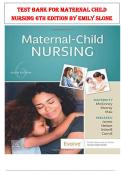Exam (elaborations)
Test bank for MATERNAL CHILD NURSING 6TH EDITION BY EMILY SLONE MC KINNEY
- Course
- Institution
- Book
Chapter 01: Foundations of Maternity, Women’s Health, and Child Health Nursing McKinney: Evolve Resources for Maternal-Child Nursing, 6th Edition MULTIPLE CHOICE 1. Which factor significantly contributed to the shift from home births to hospital births in the early 20th century? a. Puerp...
[Show more]



